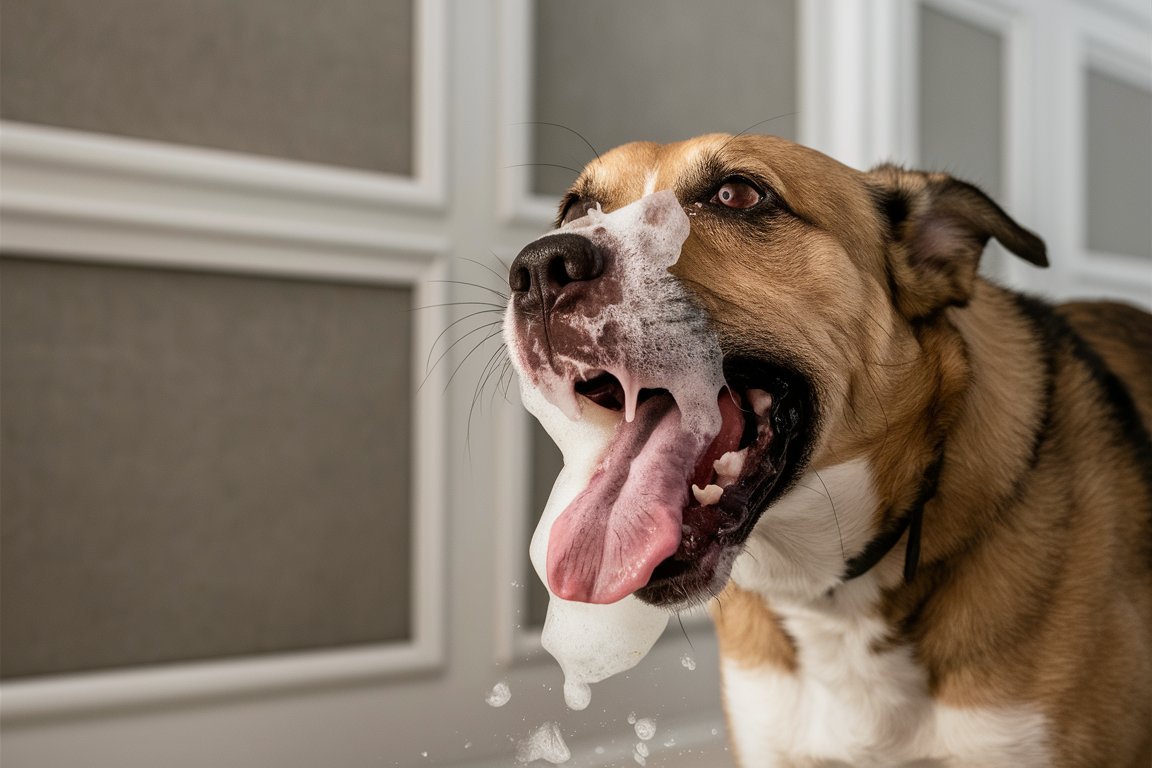Why is My Dog Throwing Up White Foam? Understanding the Causes and Solutions
Seeing your dog throwing up white foam can be alarming. You might wonder if it’s something minor or a sign of a more serious issue. Don’t worry; you’re not alone. Many pet owners have experienced the same concern, and understanding the reasons behind this unusual behavior can help you take the right steps.
What Does White Foam Vomit Mean?
White foam is usually a mix of saliva and stomach acid. When a dog vomits white foam, it’s often because the stomach is empty. This can occur for various reasons, some of which are harmless, while others might require immediate attention.
Common Causes of White Foam Vomit in Dogs
- Indigestion: One of the most common causes is simple indigestion. Dogs, like humans, can have an upset stomach. Perhaps your dog ate something that didn’t agree with them, or they ate too quickly. When the stomach is empty, and your dog feels nauseous, it can result in vomiting white foam.
- Acid Reflux: Dogs can suffer from acid reflux just like humans. This condition occurs when stomach acid flows back into the esophagus, causing discomfort and leading to white foam vomit. If your dog throws up white foam regularly, acid reflux could be the culprit.
- Gastric Dilatation-Volvulus (Bloat): Bloat is a serious condition where the stomach fills with gas and can twist, trapping the gas and causing extreme discomfort. One of the symptoms of bloat is vomiting white foam. If your dog’s abdomen is swollen and they are attempting to vomit without much coming up, seek emergency care immediately.
- Kennel Cough: Kennel cough is a respiratory infection that’s highly contagious among dogs. It causes a persistent cough, and in some cases, your dog might cough up white foam. If your dog has been around other dogs recently and starts coughing, kennel cough could be the reason.
- Parvovirus: Parvovirus is a severe viral infection, especially in puppies. It can cause vomiting, diarrhea, and lethargy. If your dog vomits white foam and shows other symptoms like severe diarrhea, this could be a sign of parvovirus, and you should seek veterinary care immediately.
- Pancreatitis: Pancreatitis is the inflammation of the pancreas, which can cause severe abdominal pain, vomiting, and sometimes white foam vomit. It often happens after a dog eats a fatty meal. If your dog appears to be in pain and is vomiting frequently, pancreatitis could be the cause.
- Toxin Ingestion: If your dog has ingested something toxic, it might vomit white foam. Toxin ingestion can be life-threatening, so if you suspect your dog ate something dangerous, contact your vet or an emergency clinic immediately.
Anecdote: A Real-Life Example
Let me share a quick story. My friend Sarah noticed her dog, Max, throwing up white foam early one morning. At first, she thought it was just a minor issue, like a mild stomach upset. However, Max continued to vomit and started showing signs of discomfort. Sarah rushed Max to the vet, where they discovered he had eaten something toxic while on a walk. Luckily, they acted quickly, and Max made a full recovery. This story emphasizes the importance of understanding your dog’s symptoms and acting promptly.
What Should You Do If Your Dog Is Throwing Up White Foam?

When you notice your dog throwing up white foam, it’s important not to panic. Here’s a step-by-step guide to help you determine what to do next:
Step 1: Observe Your Dog
The first thing to do is observe your dog closely. Are there other symptoms, such as diarrhea, lethargy, or coughing? How frequently is your dog vomiting? If it’s a one-time event, it might just be an upset stomach. However, if the vomiting persists or other symptoms appear, take note.
Step 2: Consider Recent Changes
Think about any recent changes in your dog’s life. Did you switch their food? Did they eat something unusual? Have they been around other dogs? These factors can help you pinpoint the cause.
Step 3: Withhold Food and Water
If your dog is vomiting, it’s often a good idea to withhold food and water for a few hours to let their stomach settle. After a few hours, you can offer small amounts of water and see if they can keep it down. If they don’t vomit again, you can gradually reintroduce food.
Step 4: Contact Your Vet
If your dog continues to vomit, especially if they show other symptoms like lethargy or diarrhea, contact your vet. They may want to run tests or examine your dog to rule out serious conditions like bloat, parvovirus, or pancreatitis.
Step 5: Follow the Vet’s Advice
Your vet might recommend certain treatments or dietary changes. For instance, if your dog has acid reflux, they might suggest feeding smaller, more frequent meals. If your dog has kennel cough, they might prescribe antibiotics or cough suppressants. Follow your vet’s advice closely to ensure your dog recovers quickly.
Prevention Tips
To help prevent your dog from vomiting white foam in the future, consider the following tips:
- Feed Small, Frequent Meals: If your dog is prone to indigestion or acid reflux, feeding smaller meals more frequently can help keep their stomach settled.
- Keep an Eye on What They Eat: Be mindful of what your dog is eating, especially when you’re outside. Avoid giving them fatty foods or anything that could upset their stomach.
- Regular Vet Check-Ups: Regular check-ups can help catch potential health issues before they become serious. If your dog is prone to certain conditions like pancreatitis, your vet can provide guidance on managing their diet and health.
When to Seek Immediate Help
While some instances of white foam vomiting are harmless, there are times when you should seek immediate veterinary care:
- Persistent Vomiting: If your dog is vomiting repeatedly, it could be a sign of something serious.
- Swollen Abdomen: A swollen abdomen could indicate bloat, a life-threatening condition that requires emergency treatment.
- Lethargy or Weakness: If your dog is unusually tired or weak, combined with vomiting, this could be a sign of a serious illness.
- Bloody Vomit: If there is blood in your dog’s vomit, seek help immediately.
Conclusion
Seeing your dog throw up white foam can be concerning, but understanding the potential causes can help you take the right action. Whether it’s a simple case of indigestion or something more serious like bloat or parvovirus, knowing what to look for and when to act is crucial.
By observing your dog, considering recent changes, and following the steps outlined above, you can help your furry friend feel better quickly. And remember, when in doubt, always consult your vet.
Taking proactive steps like regular vet check-ups, feeding your dog a healthy diet, and keeping an eye on what they eat can prevent many instances of white foam vomiting. With a little care and attention, you can keep your dog healthy and happy.



